Welcome to the underwater world of fish with wings, more commonly known as flying fish. In this in-depth exploration, we unravel what makes these creatures unique and also tasty. Do flying fish taste good?
Absolutely! Flying fish are a culinary delight with delicate, mildly sweet flavor. More than just gliders of the sea, they’re a gourmet treat! When fried it’s super crunchy and taste very sweet and tender.
Contents
Do flying fish intrigue your palate and curiosity? For those passionate about seafood or the marvels of marine life, the unexplored, aeronautical world of flying fish is equally fascinating and delicious.
Embark on this journey as we answer the pressing question, “Do flying fish taste good?” and uncover some astonishing facts about these extraordinary, winged marvels of the deep. Dive in to get a taste of oceanic adventure!
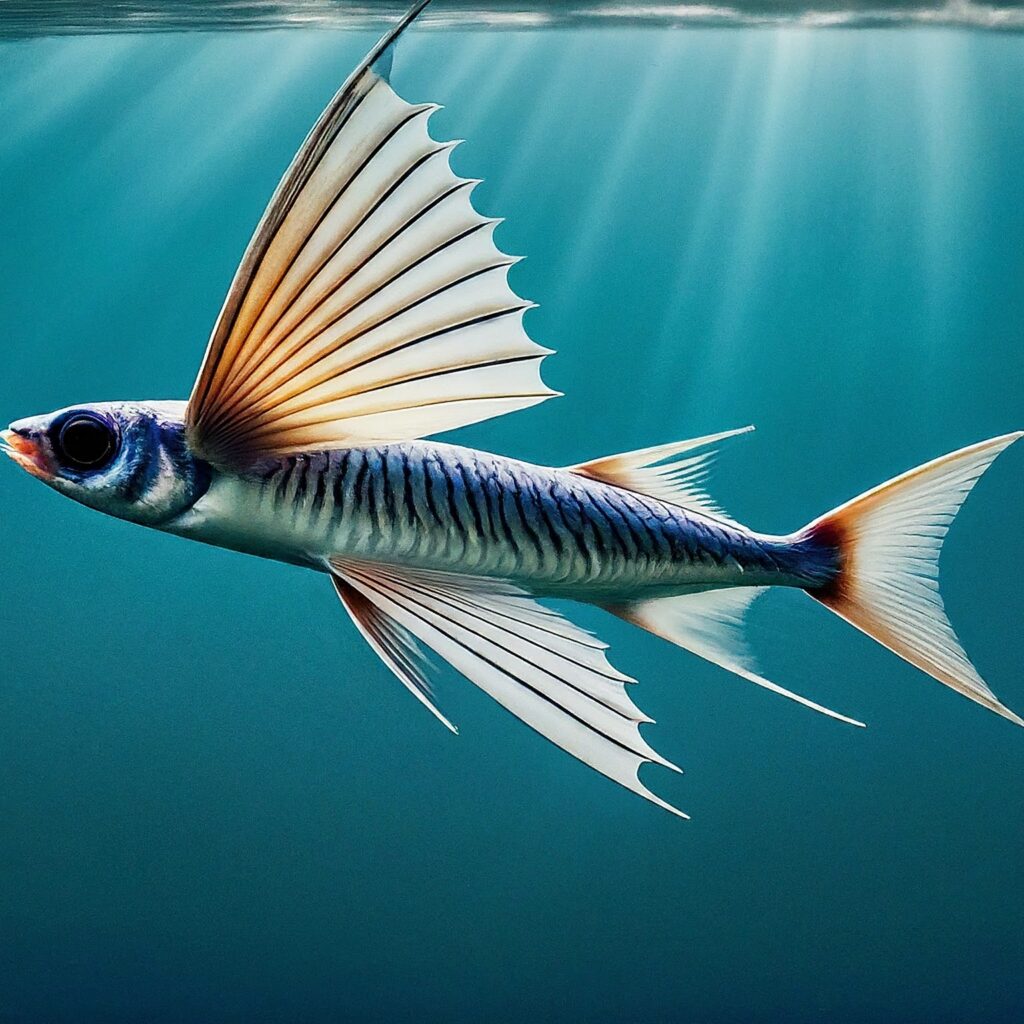
Can You Eat Flying Fish? Do Flying Fish Taste Good?
Yes, you can eat flying fish and their taste is quite delightful. Their meat is delicate, mildly sweet, and surprisingly not fishy, making them a gourmet delicacy in many parts of the world.
Flying fish are indeed as palatable as they are intriguing. While their primary habitat is the ocean, they’ve found a lucrative place on the culinary map as well.
Found in sushi or served as salty dried snacks, their mild, sweet flavor is a hit among seafood lovers. Among many cultures, eating flying fish is a cherished tradition.
Particularly in Japan, where they are an integral part of the sushi culture, flying fish, or ‘tobiuo’ as they are locally known, are served in a variety of enticing dishes.
In Barbados, the nation’s national dish, ‘Cou-cou and Flying Fish,’ showcases their culinary importance. The island nation is so fond of these winged fish that they are fondly referred to as ‘the land of the flying fish’.
Further west, Taiwan also has a thriving flying fish industry. The indigenous Tao people of Orchid Island regard these fish with wings as a pivotal part of their diet and culture.
The annual Flying Fish Festival is devoted entirely to these ocean aviators, with a variety of dishes on display.
No matter the locale, the consensus is clear: not only can you eat flying fish, but they are a global seafood delicacy, much loved for their unique flavor and texture.
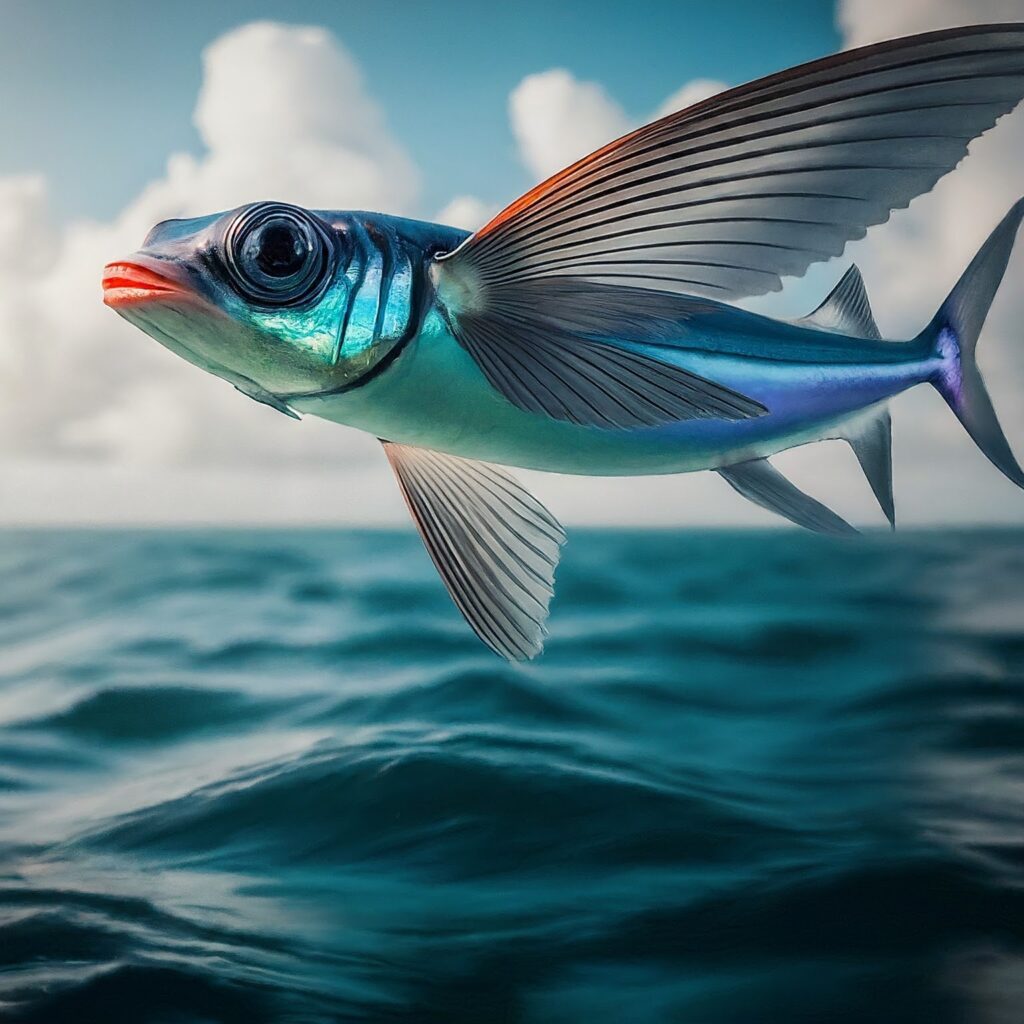
Top 3 Restaurants That Offer Flying Fish Meal In the US & UK
If you’re wondering about eating flying fish, here are some top-notch restaurants where you can find a flying fish meal:
- The Flying Fish Café in Florida: Known for offering exquisite flying fish dishes.
- The Flying Fish in Little Rock: Famous for traditional Southern food, including flying fish.
- Yumi Izakaya in London: Offers sushi dishes that include flying fish.
The table below shows other restaurant you can get flying fish meal serve to you directly, it is very important to try flying fish meal.
| No. | Restaurant | Location | Specialty Flying Fish Meal |
|---|---|---|---|
| 1. | The Flying Fish Café | Orlando, Florida, USA | Flying Fish Sushi Rolls |
| 2. | The Flying Fish | Little Rock, Arkansas, USA | Traditional Southern-style Flying Fish |
| 3. | Yumi Izakaya | London, UK | Sushi with Flying Fish |
| 4. | Barbados Seaside Grill | Bridgetown, Barbados | Cou-cou and Flying Fish |
| 5. | Ichiba Sushi | Tokyo, Japan | Tobiuo (Flying Fish) Sashimi |
| 6. | Tao Restaurant | Orchid Island, Taiwan | Many dishes featuring Flying Fish during the Flying Fish Festival |
| 7. | The Anchovy Bandit | Adelaide, Australia | Pizza topped with Flying Fish Roe |
| 8. | Hapuku Fish Shop | Oakland, California, USA | Flying Fish Tacos |
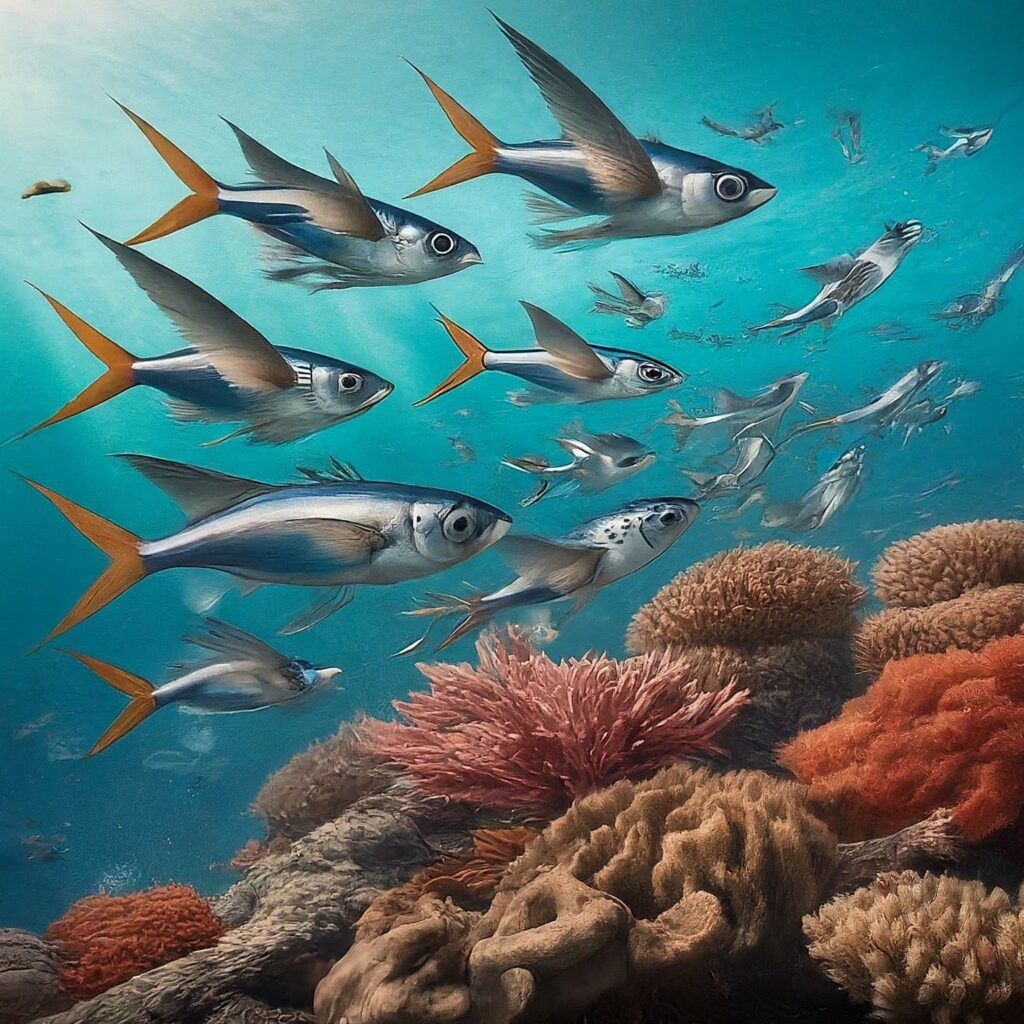
Flying Fish Interesting Facts
These fish that fly out of water are indeed real and they come packed with interesting facts:
- There are around 40 species of flying fish.
- They glide through the air, propelled by their huge pectoral fins, reaching heights of up to 4 feet and gliding distances of over 655 feet!
- The record for the longest glide by a flying fish is 45 seconds.
| No. | Flying Fish Interesting Facts |
|---|---|
| 1. | Flying Fish can glide up to 655 feet |
| 2. | There are around 40 species of flying fish. |
| 3. | They are excellent gliders, reaching heights of up to 4 feet |
| 4. | The longest recorded glide by a flying fish is 45 seconds |
| 5. | Their scientific name is ‘Exocoetidae’ |
| 6. | The largest flying fish ever recorded was 18 inches long |
| 7. | Flying Fish primarily eat plankton |
| 8. | They are a significant part of many ecosystems, serving as a vital source of food for many marine animals |
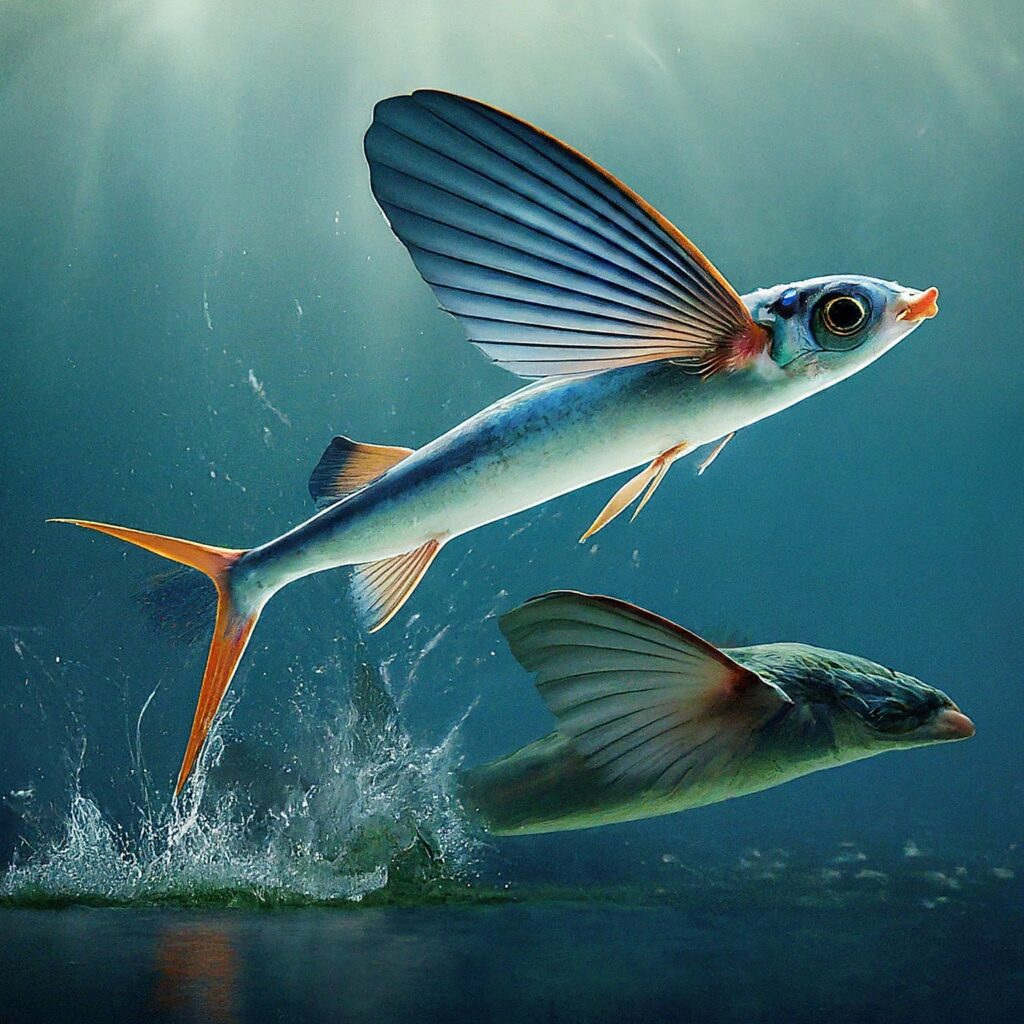
Where are Flying Fish Found? Is There A Predetermined Habitat?
Real flying fish are truly aquatic jet-setters. Embracing warm tropical and subtropical ocean waters as their preferred living spaces, they’ve expanded their boundaries to across the globe.
From the vast stretches of the Atlantic and the Pacific Ocean, these intrepid gliders have charted a course that thrives on versatility.
In the Atlantic ocean, flying fish call a multitude of diverse regions home.
From the balmy Mediterranean, with its idyllic climate and rich biodiversity, to the vibrant Caribbean Sea, known for its colorful coral reefs and dramatic marine life.
On the other side of the globe, these fish with wings make their presence known in the vast Pacific Ocean.
From the Sea of Japan, where they’re a vital part of the nation’s sushi culture, to the exotic South Pacific, home to some of the world’s most abundant and diverse marine ecosystems.
Even more remarkably, you can catch sight of these winged fish in Florida; where they exhibit the spectacle of their flight with nonchalant aplomb.
These diverse habitats play a crucial role in nurturing different species of flying fish, each with their unique characteristics.
From four-winged varieties to the charming colorful flying fish, the sheer diversity is astounding. Their widespread distribution is testament to their enduring ability to adapt and thrive.
It’s intriguing to consider how such a delicate creature can bridge different worlds – both aquatic and airborne – and call them home.

Are There Different Species of Flying Fish?
Indeed, there are a variety of flying fish types, ranging from the Two-fin flying fish to the vibrantly colorful flying fish, displaying an array of hues from turquoise blue to bright silver.

The chart above shows different species of flying fishes with percentages of the ones that are more populated.
These magnificent creatures have evolved unique adaptations that allow them to glide through the air, escaping predators and covering significant distances.
However, among the diverse flying fish species, there is a lesser-known but remarkable species named the four-winged flying fish, which stands out for its distinctive feature of extended fins.
Unlike other flying fish species, which usually possess elongated pectoral fins that function as wings for gliding, the four-winged flying fish have an additional pair of elongated pelvic fins.
These pelvic fins provide them with increased stability and maneuverability during flight, making them exceptional aerial acrobats.
The four-winged flying fish have been observed to effortlessly soar through the air for extended periods, showcasing their impressive flight skills.
In terms of physical appearance, the four-winged flying fish shares similarities with its relatives.
With a streamlined body and large, wing-like fins. However, the unique characteristic of the extended pelvic fins sets this species apart.
These extraordinary fins, in conjunction with their powerful caudal fin, enable the four-winged flying fish to achieve greater lift and control while airborne.
While the four-winged flying fish may not possess the vibrant colors of some of its counterparts.
Its exceptional flying abilities and the intriguing modification of its fins make it a fascinating subject for researchers and enthusiasts alike.
Further study and observation of this lesser-known species may unveil more secrets and insights into the evolutionary adaptations of flying fish.
Shedding light on their remarkable survival strategies in both air and water.

What Does a Flying Fish Eat? What is Their Diet?
In addition to their affinity for plankton, flying fish, recognized for their minuscule mouths.
Demonstrate inclination towards devouring small crustaceans and other minute organisms typically abundant in the vicinity of the ocean’s surface.
These exceptional marine creatures exhibit remarkable feeding adaptations, allowing them to dart out of the water and glide effortlessly above the waves.

The chart above shows what flying fish eat including their diet.
Sporting elongated pectoral fins, acting as wings, flying fish leverage this unique physiological feature to evade predators and traverse considerable distances.
Their specialized feeding habits and distinct mobility in search of food sources make them captivating inhabitants of the oceanic realm.
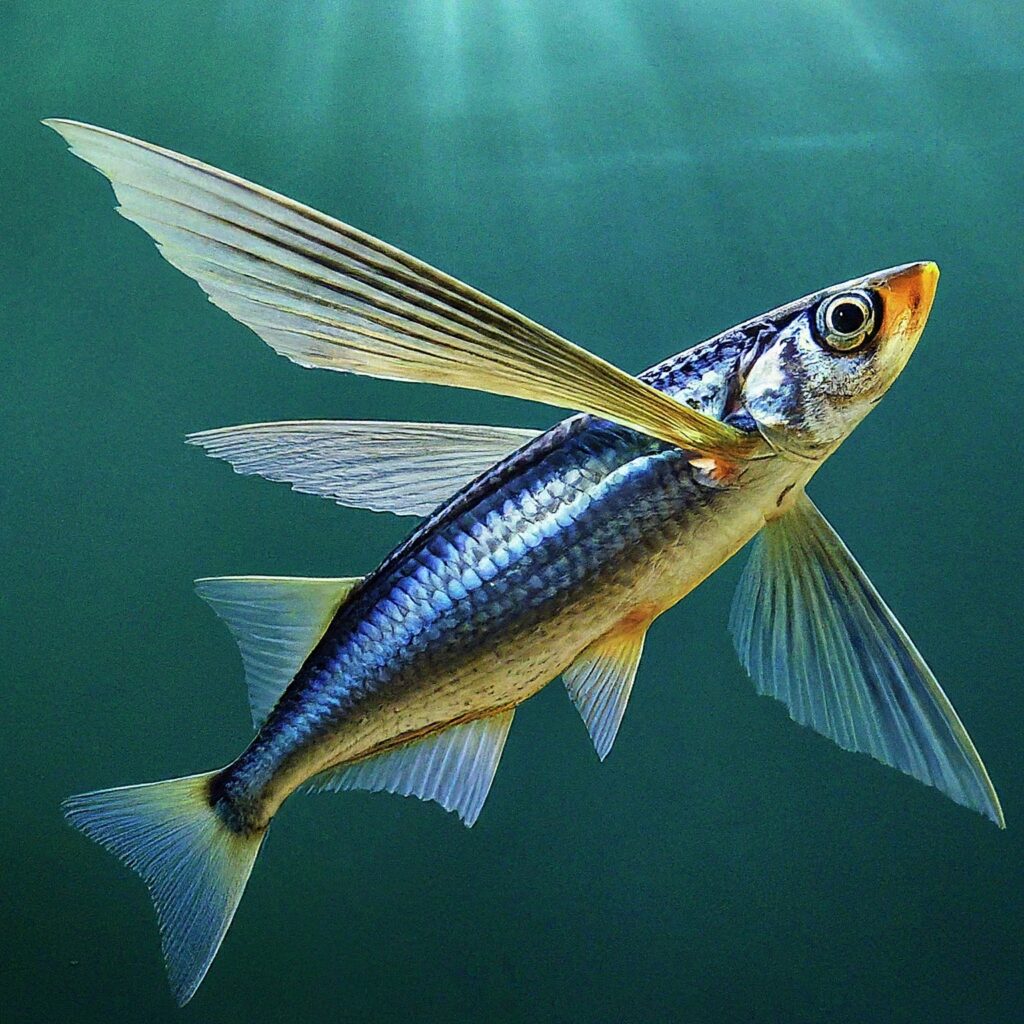
Can Flying Fish Actually Fly, and How High Can They Fly?
These astonishing fish with wings, known as flying fish, possess the extraordinary ability to glide gracefully above the water surface, although their flight cannot be compared to the majestic soaring of birds.
With remarkable agility, they can effortlessly propel themselves out of the water, ascending to heights of up to 4 feet and covering distances exceeding two football fields in their aerial ventures.
The astonishment does not end there, as these incredible creatures have even been documented achieving an awe-inspiring glide that stretched an astonishing 1300 feet!
Flying fish truly showcase nature’s innovation by blending the realms of land and sky in their daring escapades.

The chart above shows how high flying fish can fly and also distance covered each flight in a different occations.
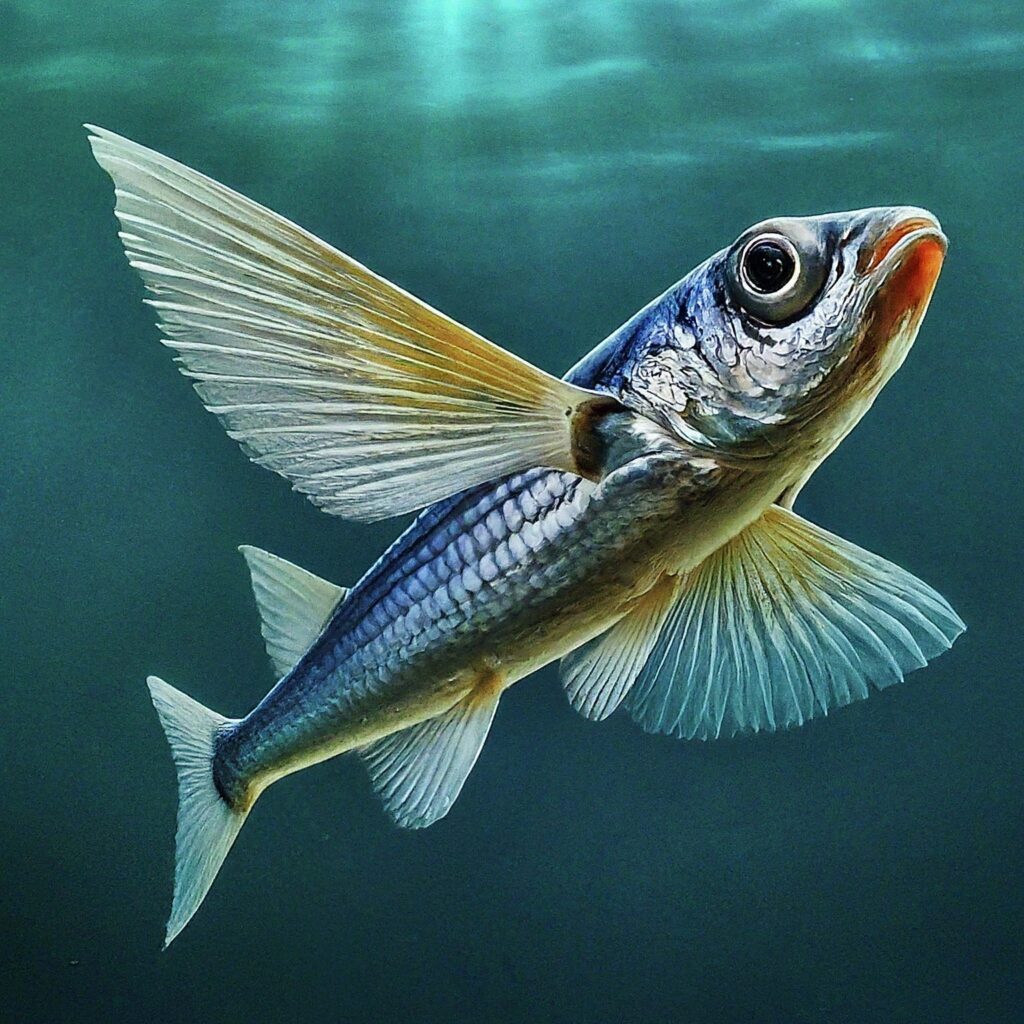
What is the Scientific Name for Flying Fish?
Their scientific name, “Exocoetidae,” aptly defines these fascinating creatures known as flying fish.
As the name suggests, they possess the remarkable ability to soar through the air, momentarily escaping the confines of their aquatic environment.
The Exocoetidae family comprises various species that have evolved specialized winglike fins, enabling them to propel themselves out of the water’s surface.
Gliding gracefully above the waves, these winged fish achieve impressive distances and heights, showcasing their unique adaptation for survival.
This exceptional characteristic has fascinated and captivated both scientists and onlookers alike, as they observe the extraordinary spectacle of fish taking to the skies.
Powered by LiveChatAIThe chart above shows scientific names of flying fish with their population in percentage.

What is the Largest Flying Fish on Record?
The Exocoetidae family includes various species of flying fish, and among them, the largest species is the “Japanese flying fish” (Exocoetus volitans).
These fish are known for their unique ability to leap out of the water and glide through the air for considerable distances.
While the size of flying fish can vary, the Japanese flying fish is one of the larger species, with reported lengths of up to 18 inches (45 centimeters) or more.
Keep in mind that sizes can vary among individual fish, and records may be subject to change as more research is conducted.
Do Flying Fish Have Wings?
Flying fish have adapted to their aquatic environment by developing elongated fins that serve as wings, enabling them to gracefully glide above the water for considerable distances.
Incredibly, these elongated fins, fusing together with their slim bodies, allow flying fish to achieve a remarkable airborne trajectory.
This unique trait provides them with the ability to escape from underwater predators or swiftly cover long distances to locate food.
While akin to wings in function, it’s important to note that flying fish do not possess true wings like birds.
These extraordinary fins greatly contribute to the exceptional agility and survival skills of these captivating creatures.
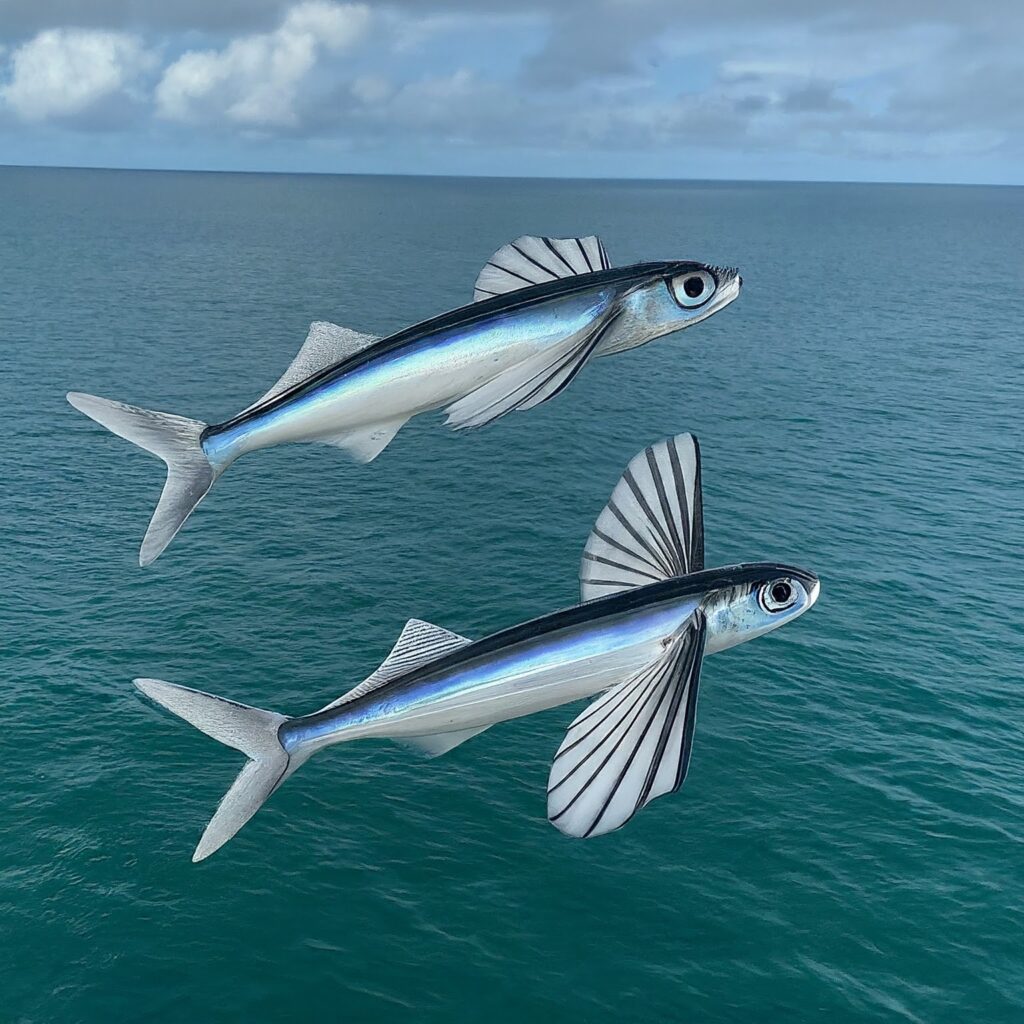
Are there any Colorful Flying Fish Species?
Not only are the colorful flying fish species, such as the Mirrorwing flying fish and the Bandwing flying fish, visually stunning, but their vivid and elegantly vibrant nature is also nothing short of mesmerizing.
These magnificent creatures effortlessly glide through the ocean waters, displaying a kaleidoscope of vibrant colors that captivate the observer’s attention.
The Mirrorwing flying fish enchants with its shimmering silver scales, while the Bandwing flying fish boasts striking bands of iridescent hues along its slender body.
These remarkable species have adapted to their environment, perfecting the art of flight underwater, making them even more remarkable and sought after.
What Eats Flying Fish in Their Natural Habitat?
In the vast expanse of the ocean, the mesmerizing flying fish lure the attention of predators in search of their next meal.
This agile species becomes an enticing delight for larger marine creatures, including the powerful tuna, majestic swordfish, and the majestic marlin.
As if nature’s tableau wasn’t captivating enough, the skies above witness a captivating spectacle as well.
Birds, such as frigate birds and gulls, partake in the feast, feasting on these succulent morsels of the sea with exceptional grace.
Swift and skilled, they skillfully pluck the flying fish mid-flight, turning the ocean’s delicacies into airborne treats.

How Long Can Flying Fish Fly? Distance Covered While Flying
Flying fish are remarkable creatures known for their ability to glide through the air for astonishing distances of up to 655 feet.
Not only that, but their flights can clock in at an impressive duration of up to 45 seconds. However, it’s worth noting that these remarkable feats can be further enhanced by Mother Nature herself.
When a tailwind accompanies their flight, the flying fish can greatly benefit from the added propulsion, enabling them to cover even greater distances than previously observed.
The force of a tailwind acts as a natural booster, propelling these awe-inspiring fish to even more remarkable distances in their airborne adventures.
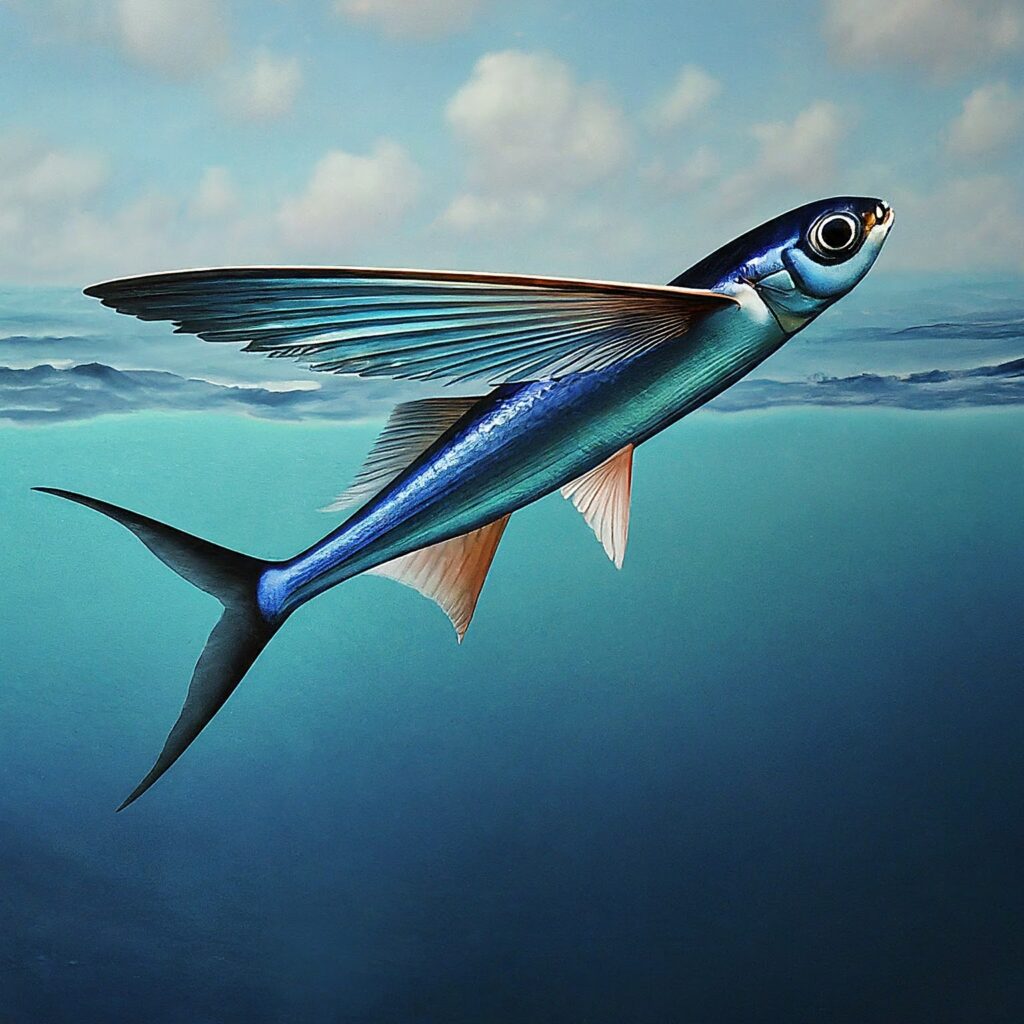
What Do Flying Fish Contribute to Their Ecosystem?
Flying fish are vital components of marine ecosystems, playing a significant role in maintaining the balance and health of their environment.
These remarkable creatures serve as essential links in the food chain, serving as both predators and prey.
Their ability to swiftly launch themselves out of the water and glide through the air enables them to escape from predators and seek out sources of food, ensuring their survival.
Another important aspect of flying fish is their designation as ‘bio-indicators,’ providing crucial insights into the well-being of marine ecosystems.
Researchers and scientists carefully study the presence, behavior, and abundance of flying fish populations as an indicator of the overall health and stability of these environments.
By monitoring the population dynamics of flying fish, scientists can better understand the impact of various factors such as pollution, climate change, and overfishing on marine ecosystems.
Furthermore, changes in the behavior or population of flying fish can alert scientists to potential threats or imbalances within the ecosystem.
For instance, a decline in flying fish populations may indicate overfishing or habitat degradation, prompting conservation efforts to rectify these issues.
Therefore, these incredible creatures not only contribute to the food web but also provide valuable insights and assist in the conservation and management of marine ecosystems.

Conclusion
So, do flying fish taste good? Evidently, they do, and these fascinating creatures are more than just a novelty – they are a significant species that contribute to the biodiversity and complexity of our world’s oceans.
So, whether you encounter them on your dinner plate or during a deep-sea dive, there’s no denying that flying fish are among the most fascinating creatures of the sea!
Other related articles
- Do Flying Fish Taste Good? Things You Don’t Know About Flying Fish
- 5 Compelling Reasons Why Fish Farming is Essential
- North Carolina Fishing License Walmart: A Comprehensive Guide
- Walmart Fishing License Colorado: Everything You Need to Know
- Innovative Techniques for Today’s Anglers | Check It Out
- Taimen Fish | Exploring the Facts and Fascination

Joe and Christabel, we have been into aquarium and beauty addition to homes and officeses since 2007, aquatic life and care is our passion for years, feel free to learn more.

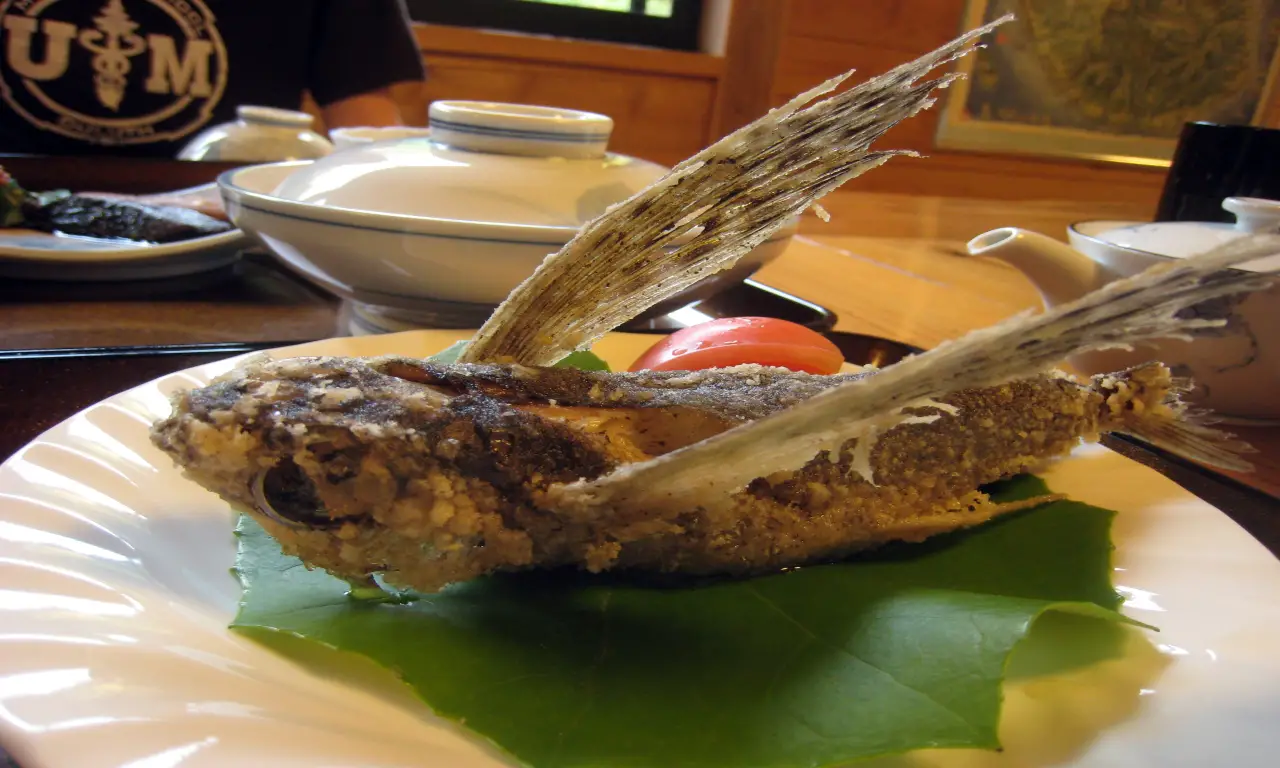
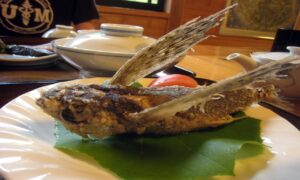
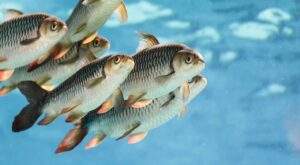

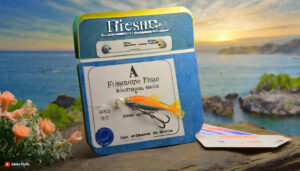




Leave a Reply